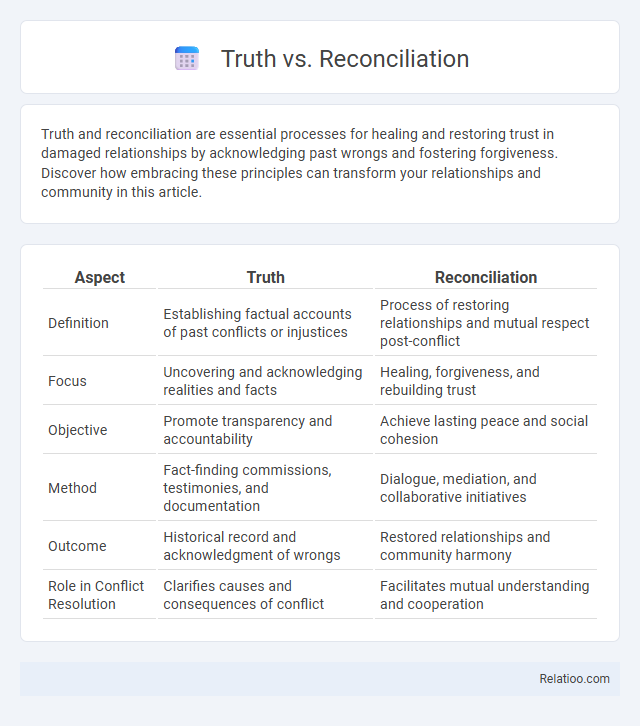Truth and reconciliation are essential processes for healing and restoring trust in damaged relationships by acknowledging past wrongs and fostering forgiveness. Discover how embracing these principles can transform your relationships and community in this article.
Table of Comparison
| Aspect | Truth | Reconciliation |
|---|---|---|
| Definition | Establishing factual accounts of past conflicts or injustices | Process of restoring relationships and mutual respect post-conflict |
| Focus | Uncovering and acknowledging realities and facts | Healing, forgiveness, and rebuilding trust |
| Objective | Promote transparency and accountability | Achieve lasting peace and social cohesion |
| Method | Fact-finding commissions, testimonies, and documentation | Dialogue, mediation, and collaborative initiatives |
| Outcome | Historical record and acknowledgment of wrongs | Restored relationships and community harmony |
| Role in Conflict Resolution | Clarifies causes and consequences of conflict | Facilitates mutual understanding and cooperation |
Understanding Truth: Defining the Core Concept
Truth involves the accurate and comprehensive acknowledgment of historical facts, especially regarding past injustices. Reconciliation depends on this truth as its foundation, facilitating healing and restoring relationships between affected parties. Unlike generic reconciliation, Truth and Reconciliation processes specifically prioritize uncovering and validating truths to address systemic wrongs and foster genuine societal repair.
The Essence of Reconciliation: Beyond Forgiveness
The essence of reconciliation extends beyond mere forgiveness, encompassing a deep restoration of trust and mutual respect between conflicting parties. Truth serves as the foundation, providing an accurate acknowledgment of past injustices essential for genuine reconciliation. This process promotes healing by addressing systemic wrongs and fostering accountability, rather than simply seeking emotional pardon.
Historical Roots of Truth and Reconciliation
Truth and Reconciliation processes stem from historical efforts to address past injustices by uncovering facts and fostering healing between conflicting parties. The Truth component emphasizes uncovering historical truths about systemic abuses, often through formal inquiries or commissions, while Reconciliation focuses on rebuilding relationships and repairing social trust. Your engagement with these processes supports acknowledgment of historical realities and promotes collective healing.
Why Truth Matters Before Reconciliation
Truth serves as the foundation for genuine reconciliation by uncovering the facts and experiences that need acknowledgment and healing. Without confronting the truth, attempts at reconciliation risk becoming superficial or insincere, leaving underlying wounds unaddressed. Your engagement in truth-telling creates a pathway for meaningful reconciliation rooted in justice and mutual understanding.
Common Barriers to Truth in Social Healing
Common barriers to truth in social healing include denial, fear of retribution, and entrenched narratives that resist acknowledging past injustices. Power imbalances often hinder transparent dialogue, limiting opportunities for genuine reconciliation. Overcoming these obstacles requires creating safe spaces for marginalized voices and fostering a collective commitment to historical accuracy and accountability.
Psychological Impact: Truth vs Reconciliation
Truth processes prioritize uncovering and acknowledging painful past atrocities to validate victims' experiences, fostering psychological healing. Reconciliation emphasizes rebuilding trust and relationships between conflicting parties, often requiring ongoing dialogue and empathy development. Your psychological recovery benefits when truth-telling initiates the emotional validation needed before genuine reconciliation can occur.
Global Case Studies: Truth and Reconciliation Processes
Truth and Reconciliation Commissions (TRCs) serve as pivotal mechanisms in addressing historical injustices by facilitating official acknowledgment of human rights violations, as seen in South Africa's post-apartheid TRC and Canada's Truth and Reconciliation Commission on Indigenous residential schools. These processes emphasize uncovering truth, promoting restorative justice, and fostering societal healing through victim testimony and perpetrator accountability, distinguishing them from broader reconciliation efforts that may lack structured institutional frameworks. Global case studies demonstrate that effective TRCs balance truth-telling with reparations and reforms, contributing to sustainable peace and national cohesion amid post-conflict recovery.
Measuring the Success of Truth vs Reconciliation
Measuring the success of Truth vs Reconciliation requires evaluating tangible outcomes such as social healing, justice delivery, and policy reforms addressing past injustices. You can assess effectiveness by analyzing the implementation of recommendations, public awareness levels, and restoration of trust among affected communities. Quantitative data on reduced conflicts and qualitative improvements in intergroup relations provide critical indicators for the reconciliation process.
Criticisms and Controversies Surrounding Both
Truth commissions often face criticism for prioritizing confessions over justice, leading to perceptions of impunity and dissatisfaction among victims. Reconciliation efforts can be controversial as they sometimes pressure victims into forgiveness without addressing systemic inequalities or legal accountability. Both processes risk oversimplifying complex historical grievances, resulting in unresolved tensions and debates about their effectiveness in achieving lasting peace.
Building Sustainable Peace: Integrating Truth with Reconciliation
Building sustainable peace requires integrating truth-telling processes with reconciliation efforts to address historical injustices and foster mutual understanding among conflicting parties. Truth commissions provide a vital platform for victims to share experiences and establish an accurate historical record, which helps communities acknowledge past harms and prevent denial. Reconciliation initiatives that follow these truth processes promote healing, social cohesion, and the establishment of trust, creating a foundation for lasting peace.

Infographic: Truth vs Reconciliation
 relatioo.com
relatioo.com